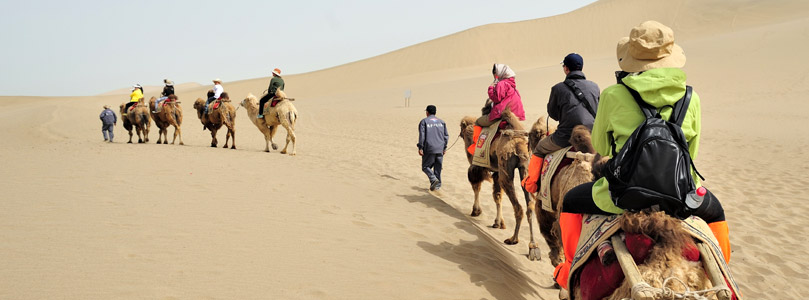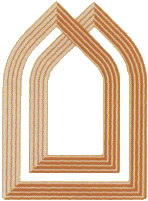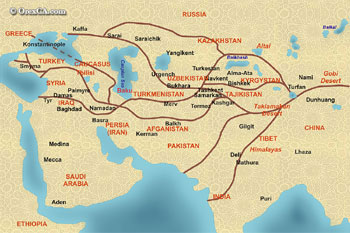Silk Road Travel Guide

 The Great Silk Road is the popular name given to the system of caravan trade routes that lasted for many centuries and linked Eastern and Western civilization between the Ancient and Middle Ages.
The Great Silk Road is the popular name given to the system of caravan trade routes that lasted for many centuries and linked Eastern and Western civilization between the Ancient and Middle Ages.
The main route of the Silk Road traveled through China along the Gan-Su corridor, then through the Tarima basin, and the highlands of the Pamir and Tian-Shan ranges, into Central Asia, Afghanistan, Iran, the Eastern shores of the Mediterranean Sea, and still further along to the trading centers of the Near East, Countries of the Silk Road, and Europe.
The Great Silk Road first operated as a route between China and the capital of the Roman Empire in the 2nd century BC. It was approximately 7000 kilometers long. The most valuable commodity imported from China was silk, which is an obvious explanation why this entire transcontinental trade route was named The Silk Road.
The Great Silk Road is, in fact, a network of routes which played a highly significant role in the lives of many people in Eurasia. It was an important artery in the Ancient and Middle Ages, a source of merchandise and information, and the starting point of many conflicts and wars. Along this route sprang into existence, and fell into decline, many nations and cultures, great powers, trade centers, and capitals of many of the former empires of the world. Trade centers and capitals of these empires appeared, flourished and gained fame, and then decayed and declined.
The Great Silk Road is one of the most significant achievements in the history of world civilization. The widespread network of caravan routes crossed Europe and Asia from China to the Mediterranean coast and in ancient times served as an important means of business relations and cultural exchange between East and West. The longest part of the Silk Road lies across the territory of Central Asia and Kazakhstan.
 Caravans laden with silk from China, spices and precious stones from India, silver goods from Iran, Byzantine clothes, Turkic slaves, Afrosiabian ceramics, and many other goods, moved through the Kara-Kum and Kyzyl-Kum deserts, the boundless steppes of Sary-Arka; passed over the ridges of the Pamirs and Tian-Shan , Altai and Karatau Mountains; and crossed the rivers Murgab, Amu Darya and Syr Darya.
Caravans laden with silk from China, spices and precious stones from India, silver goods from Iran, Byzantine clothes, Turkic slaves, Afrosiabian ceramics, and many other goods, moved through the Kara-Kum and Kyzyl-Kum deserts, the boundless steppes of Sary-Arka; passed over the ridges of the Pamirs and Tian-Shan , Altai and Karatau Mountains; and crossed the rivers Murgab, Amu Darya and Syr Darya.
Along the route of the caravans were rich settlements and towns - Merv (Turkmenistan); Bukhara, Samarkand, Urgench and Khiva (Uzbekistan); Otrar, Taraz and Chimkent (Kazakhstan); Dgul, Suyab, Novokent, Balasagun, Borskon, Tash-Rabat, Osh and Uzgen (Kyrgyzstan).
The first, the Southern branch, ran from Termez via Samarkand to Dushanbe's present location, along a tributary of the Kyzyl-Su up to Alai and exited in the area of modern Irkishtam, where it switched direction towards Kashgar.
The second, the Fergana branch, led from Samarkand via Hodjent to Isfara, Kokand and Osh.
The third, Northern branch came from Zamin Rabat to Benkent (Tashkent) , Isfidjab (Chimkent), Taraz (Jambyl), Nuzket (Kara-Balta), and Balasugun (Burana). From there, caravans traveled along the Boom Canyon to reach the Issyk-Kul area and further to China across the San-Tash range.
The caravan traffic proceeded at a slow pace. A good day's journey covered 8 farsahs (50 km), a not so good one 4 farsahs (25 km). The composition of the caravan trains varied. There are numerous records of some huge trains containing up to 10,000 beasts of burden. All along the route, caravan-sarais (meeting places) appeared at regular intervals. Torrential streams were tamed with bridges. There was little caravan traffic from China to the Mediterranean. Because the international route opened up access to new places, settled crop production began, alongside nomadic livestock breeding.
The pioneer of the Great Silk road as considered by historians was Chzan Tsan, a Chinese diplomat who lived in the 1st century B.C. The fact that Central Asia had been conducting trade in the Tian-Shan is verified by the large amount of Chinese coins, bronze looking glasses, silk remnants, and fragments of Chinese pottery which have been found by archeologists. Thanks to China, silkworm breeding and paper manufacturing began developing in Central Asia, whereas it was due to Central Asia that China took up cultivation of grapes, alfalfa, onions, cotton, pomegranates, walnuts, fig trees and cucumbers.
A modest commercial traveler called Franchesco Pegolotti, of Bardi's firm in Florence, came home to Italy in 1355 after eight years of traveling. He had covered thousands of Chinese leas, Arab farsahs and European miles of the Great Silk Road. He became the author of a book that was titled "Trade practice, or a treatise on land division, trade measures, and other things the knowledge of which is necessary for merchants of all countries".
One irony is that the ancient path of merchants of the East and the West got its name in the 19th century. The name was proposed by Ferdinand von Richthofen, the author of classical works on the physical geography of China and Asia's topography. Thus, following his example, this name is recognized all over the world. Warmly welcomed by the world public is the decision of UNESCO on the realization of the international program "The Great Silk Road" - a route of dialogue, mutual understanding and rapprochement of cultures. The Great Silk Road, like the Phoenix bird, is beginning its revival. .
Begin your journey! You will see splendid architecture, become one with stunning nature, feel the hot wind of deserts and admire dazzling mountain summits.
